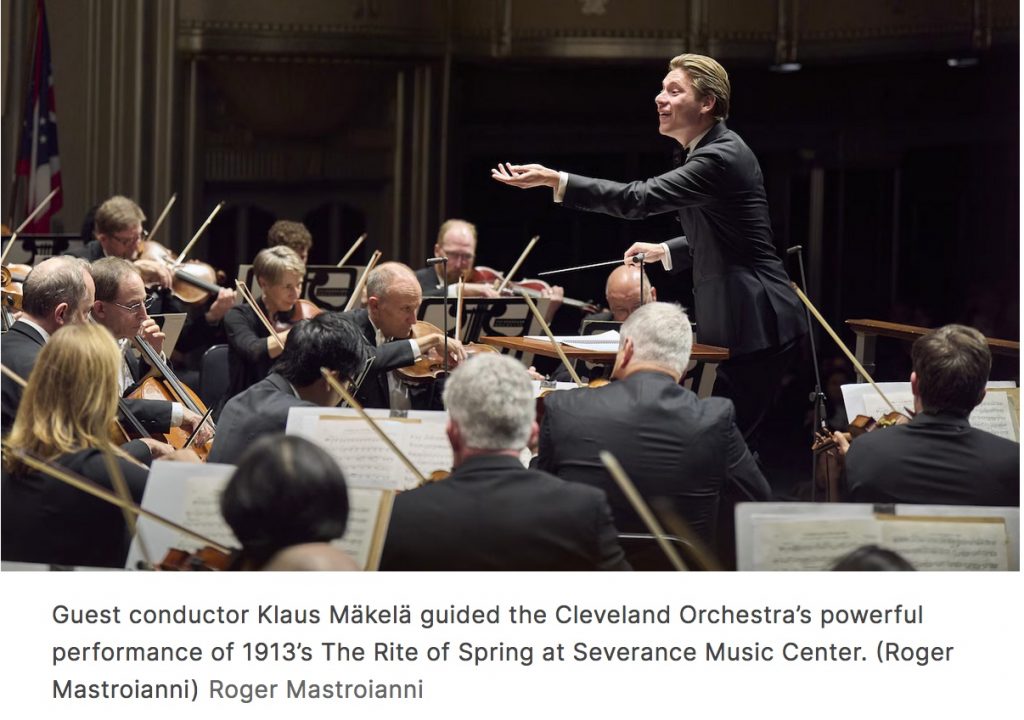by Daniel Hathaway | Cleveland Classical
Originally published on Cleveland.com

Igor Stravinsky’s 1913 ballet score The Rite of Spring gave the conductor and orchestra the raw material for their task, but the large body of musicians dug deep into their physical resources, producing a Rite that was singularly explosive and terrifying in its power, but no less variegated than what nature itself was serving up.
But more about that later. The evening began with an engaging oddity: Darius Milhaud’s Le Boeuf sur la toit (The Ox on the roof), a 15-minute curtain raiser originally written to accompany any of Charlie Chaplin’s silent films.
Dancing percussion lines, catchy folk-like melodies and an earworm of a main theme recur over and over amid sudden mood changes from the funky to the sentimental, giving many in the orchestra opportunities to shine. Mäkelä paced the piece cannily and ratcheted up the tempo for an exuberant ending.
In its hundredth anniversary year, performances of every possible version of George Gershwin’s Rhapsody in Blue are popping up everywhere, which made Jean-Yves Thibaudet’s choice of Gershwin’s jazz-infused Concerto in F especially welcome.
His first entrance was preceded by a grand orchestral opening before he unleashed an immense power that easily cut through Gershwin’s thick orchestral writing. With its commandanding technical challenges and sweeping, lush melodies, the concerto seemed tailor-made for this pianist.
Another long introduction to the second movement featured solo horn and winds before Michael Sachs introduced a seductive, bluesy trumpet solo that invoked Broadway-inspired melodies and alternated with elegant piano motifs.
The highly rhythmic finale found Thibaudet passing fast passages back and forth with the orchestra before a strike of the gong signaled the concerto’s mesmerizing, breathless ending.
The near-capacity crowd immediately erupted into a well-deserved ovation. Although Thibaudet and Mäkelä, a perfectly-matched pair, received numerous call-backs, there was no encore, and rightly so. What more needed to be said?
While Stravinsky’s The Rite of Spring posed a challenge for musicians when it burst onto the scene in 1913, over time players and conductors have mastered its technical complexities. That doesn’t mean that it’s not still a major event when the piece is programmed — what kind of interpretation will a conductor bring to a performance?
Klaus Mäkelä’s contribution on Thursday was an intense, physical involvement in the score. He gave himself a full-body workout on the podium that might have seemed self-indulgent, except that it was so honest a response to the music and so direct a communication with his players.
Bassoonist John Clauser introduced the Adoration of the Earth with an yearningly exquisite solo. As the narrative moved forward, more winds joined, creating inventive instrumental pairings — E-flat and bass clarinet (Daniel McKelway and Amy Zoloto) and later E-flat clarinet and alto flute (McKelway and Jessica Sindell). A procession crowned with majestic Wagner tubas introduced the seismic climax of the Dance of the Earth and the conclusion of Part I.
After holding the silence for a long minute, Mäkelä set up the dramatic opening of Part II, leading to the famous 11/4 bar that beckons everything to break loose. The volume grew so subtly that just when you thought the hall couldn’t contain any more sound, Mäkelä unleashed heralding calls from the eight horns, making a wonderful sonic transition into the concluding Sacrificial Dance.
Mäkelä’s pacing with its subtle tempo changes moved Stravinsky’s music from one section to another, all the while allowing an enormous arch to emerge that is frequently lacking in performances. The conductor built the work to a formidable climax, inspiring an equally tremendous response from the audience.
If you don’t have tickets for either of the remaining performances this weekend — get them now before it’s too late.
Published on ClevelandClassical.com April 23, 2024.
Click here for a printable copy of this article
Return to the Front Page.



